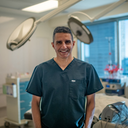Posted underBreast Implants q&a
Saline Breast Implants - Palpable Nodule on Breast Normal 9 Weeks Post-op?
I'm 9 weeks post-op after my saline breast implants. I noticed a nodule like projection on the lower pole of one breast which felt exactly like pressing on the resilient scalloped edges of sides of the implant shell, as early as 2 weeks post-op.
My PS told me my skin was much thinner along this area. When I wear a sheer bra, this lump is noticeable and palpable. When touched, it's extremely weird like touching a breast with 'cysts' except that these lumps can be pressed and bounce back.
Is this a common occurence? Is it normal to have palpable linear nodule-like projection arising from the rippling effects of saline implants? Will it get worse? If yes, what are remedial options?
Answers (15)
From board-certified doctors and trusted medical professionals
Dr. Shahram Salemy, MD, FACS

Dr. Shahram Salemy, MD, FACS
Board Certified Plastic Surgeon
Answer
Dr. Richard J. Bruneteau, MD

Dr. Richard J. Bruneteau, MD
Board Certified Plastic Surgeon
Answer
Dr. Vincent N. Zubowicz, MD

Dr. Vincent N. Zubowicz, MD
Board Certified Plastic Surgeon
Answer
Dr. Richard H. Fryer, MD

Dr. Richard H. Fryer, MD
Board Certified Plastic Surgeon
Answer
Dr. Jeffrey Zwiren, MD
Dr. Jeffrey Zwiren, MD
Board Certified Plastic Surgeon
Answer
Dr. Carmen Kavali, MD
Dr. Carmen Kavali, MD
Board Certified Plastic Surgeon
Answer
Dr. Samir Shureih, MD
Dr. Samir Shureih, MD
Board Certified Plastic Surgeon
Answer
Dr. Steven Wallach, MD
Dr. Steven Wallach, MD
Board Certified Plastic Surgeon
Answer
More Breast Implants Questions
See all Breast Implants Q&AWE SEND PRETTY
EMAILS
What’s trending? Who’s turning heads? Which TikTok myths need busting? We’ve got you. No fluff, no gatekeeping—just real talk. Get our free, unfiltered newsletter.
